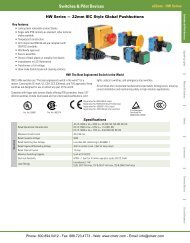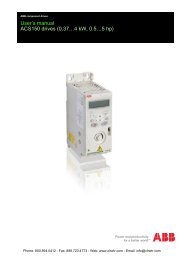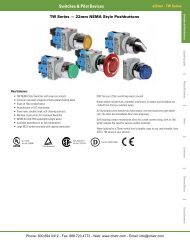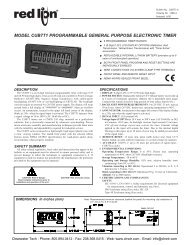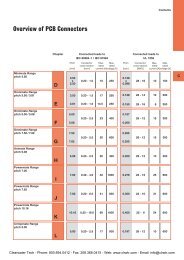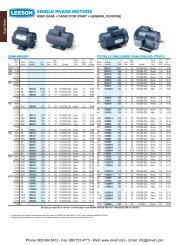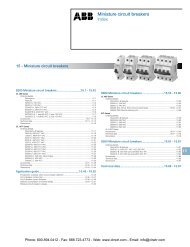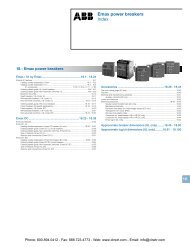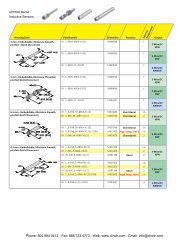IDEC / Datasensor Sensors - Clearwater Technologies, Inc.
IDEC / Datasensor Sensors - Clearwater Technologies, Inc.
IDEC / Datasensor Sensors - Clearwater Technologies, Inc.
You also want an ePaper? Increase the reach of your titles
YUMPU automatically turns print PDFs into web optimized ePapers that Google loves.
<strong>Sensors</strong><br />
General Information<br />
Slot <strong>Sensors</strong><br />
A slot sensor is a version of a through-beam retro-refl ective sensor,<br />
where the emitter and receiver are<br />
placed opposite each other on the<br />
inside of an U-shaped housing. Any target that<br />
passes through the internal slot interrupts the<br />
beam and is detected. Due to their construction,<br />
slot sensors are great for applications with short<br />
operating distances. The most typical slot sensor<br />
applications are hole or teeth detection on gears,<br />
label detection, or edge control and continuity of<br />
sheets or tapes. The emission is generally<br />
infrared light; however visible red or green<br />
emission versions are available and able to detect references such as registration<br />
marks, that present color contrasts on transparent fi lm.<br />
Contrast <strong>Sensors</strong><br />
Contrast sensors (also defi ned as color mark readers) present a<br />
proximity function but, instead of detecting only the presence or<br />
absence of an object, they are able to distinguish between two<br />
surfaces. This accomplished by<br />
detecting the contrast produced by<br />
the different reflection degrees. In<br />
this manner a dark reference mark<br />
(low refl ection) can be detected<br />
due to the contrast with a lighter<br />
surface (high reflection), or vice<br />
versa. In the presence of colored<br />
surfaces, the contrast is highlighted<br />
using an LED, typically red or<br />
green. For general purposes a white light is used because the full light spectrum<br />
detects the majority of contrasts. White light emission is obtained through<br />
lamps, or LEDs in most sensors, enabling the detection of very slight contrasts<br />
due to different surface treatments, even of the same material and color.<br />
Contrast sensors are mainly used in automatic packaging machines for registration<br />
mark detection to synchronize folding, cutting and welding.<br />
Contrast on White Background<br />
Mark Color Red LED Green LED White LED<br />
Red no medium medium<br />
Orange low medium medium<br />
Yellow low low medium<br />
Green high no medium<br />
Blue high medium high<br />
Violet medium high high<br />
Brown low medium high<br />
Black high high high<br />
Gray medium medium medium<br />
White no no yes<br />
Luminescence <strong>Sensors</strong><br />
‘Luminescence’ is defi ned as visible light emission from fluorescent or<br />
phosphorous substances, due to electromagnetic radiation absorption.<br />
Luminescence sensors emit ultraviolet light, which is reflected at a<br />
higher wavelength (minor energy) on a<br />
fl uorescent surface, shifting into the<br />
visible light spectrum. Ultraviolet light<br />
emission is obtained using special<br />
lamps, or LEDs in sensors. UV<br />
emission is modulated and the visible<br />
light reception is synchronized.<br />
Maximum immunity against external<br />
interferences, such as refl ections<br />
caused by very shiny surfaces, is<br />
obtained. In addition, fl uorescent targets, invisible to the human eye, can be<br />
detected. Luminescence sensors are used in various industries: detecting labels<br />
on glass or mirrors in pharmaceutical and cosmetic fi elds; selecting tiles marked<br />
with fl uorescent marks in the ceramic industry; determining the presence of<br />
fl uorescent glues on paper for automatic packaging; distinguishing cutting and<br />
sewing guides in textile manufacturing; checking fl uorescent paints or lubricants<br />
in mechanical production.<br />
Color <strong>Sensors</strong><br />
The color of an object depends on all the color components of the<br />
incident light which are being refl ected, eliminating those which have<br />
been absorbed. The dominant color is defi ned as ‘hue’ and depends on<br />
the refl ected light’s wavelength.<br />
‘Saturation’ indicates<br />
the pureness of the color with<br />
respect to white and is<br />
represented as a percentage.<br />
Hue and saturation together<br />
are defi ned as ‘chromaticity’.<br />
Color or chromatic sensors<br />
have a proximity function with<br />
generally three RGB LEDs for<br />
light emission. The color of<br />
an object is identifi ed according to the different refl ection coefficients obtained<br />
with red (R), green (G) and blue (B) light emissions. More simply, yellow can be<br />
identifi ed by R=50% G=50% B=0% refl ections; orange by R=75% G=25% B=0%<br />
refl ections; pink by R=50% G=0% B=0% refl ections; but possible combinations<br />
are really infi nite. Color sensors operate only on refl ection ratios and are not infl<br />
uenced by light intensity, defi ned as ‘brilliance ‘or ‘luminance’. There is a wide<br />
range of applications, ranging from quality and process controls, to automatic<br />
material handling for identifi cation, orientation and selection of objects according<br />
to color.<br />
Fiber Optic <strong>Sensors</strong><br />
Universal functions of through-beam and proximity sensors, as well as<br />
application functions ranging from contrast and luminescence to color<br />
detection, can be obtained using fi ber optic sensors. The optical fibers<br />
can be thought of as cables that transport light and can be used to place the<br />
sensor’s optics in small spaces, or to detect very small objects.<br />
An optical fi ber is composed of cylindrical glass (or a plastic core), surrounded<br />
by Tefl on or Silicon coating. The difference between the core and the coating<br />
refraction indexes allows the light to be diffused inside the fi ber in a guided<br />
manner. The coating is covered by a plastic or metal sheath, which has an exclusively<br />
mechanical protection function. Fibers with a glass core and metal sheath<br />
are suitable for very high temperature uses, or for particular mechanical requirements.<br />
Plastic fi bers, offering great adaptability, are the most diffused in all<br />
PLCs Operator Interfaces Automation Software Power Supplies <strong>Sensors</strong> Communication & Networking<br />
<strong>Clearwater</strong> Tech - Phone: 800.894.0412 - Fax: 208.368.0415 - Web: www.clrwtr.com - Email: info@clrwtr.com235





